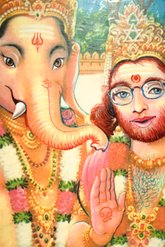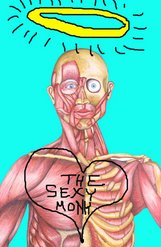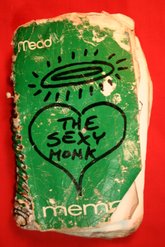
Today, I decided to show you Mma Seitsang's (See "About the South Africa Series") favorite drawing from this series. This picture deals with the witchcraft and the battle of good and evil. In the places where I lived in rural South Africa, I found the belief in witches, warlocks, and demons nearly universal. This may seem silly or quaint if you grew up in Europe or the US, but the belief is sincere and very strongly held. Plus, before you start getting all superior and secular-humanist on me, remember that the last witches were burned in the "developed world" around 200 years ago (a blink in historical time.) For more information on this topic, check out:the artwork of Goya, the histories of the Plymouth and Jamestown colonies, a happy little German missive called "The Hammer of Witches," and an excellent book by the late scientist Dr. Carl Sagan entitled "Demon Haunted World." I recommend reading these things only in the daytime, as the historical accounts of the witch hunts would make even a Stephen King fan check under his bed. Because witches, ghosts, and ancestor spirits were usually described to me as looking like "normal people." As you can imagine, this made my job as an artist trying to depict the world of African spirituality much more difficult. So, I was always thankful to talk with someone who claimed to have seen or dreamt about anything out of the ordinary. The witch shown in this picture (far right)was a character in a story told to me by a fellow teacher from the Rustenburg area of the Northwest Province. My friend was very specific about the appearance of the witches: both male and female witches (the word "warlock" or its equivalent was never used) are naked save for a garland of severed penises shielding the eyes and a string of severed fingers covering the nipples. Witches are accused of all manner of terrible crimes and outrages. In this case, I have depicted a female witch dragging a bloody naked man. This is bases on a rumor that circulated in the village where I did my Peace Corps work during the summer of 2004. The shaman in the center is dressed in red, white, and black, the same outfit worn by students at Mma Rabotapi's traditional healer school (a sort of African version of Hogwarts) where I had the opportunity to visit and study (more about Mma Rabotapi in future posts.) In one hand, the shaman is carrying a fly whisk-this traditional Pan-African symbol of royalty is used extensively in ceremonies where sea water or liquid medicine is flung to banish evil spirits. In the other hand he carries a club fashioned from the tough root ball of a tree. This object is known as a herding stick. It is found in many African homes and used often for "encouraging" cattle or home defense. This sign of manhood is presented to boys who have completed training in a circumcision school.



No comments:
Post a Comment